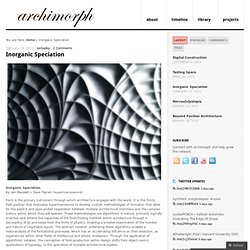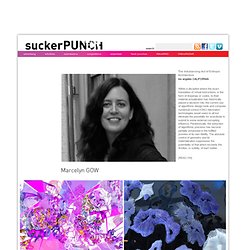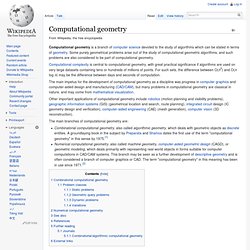

Optimization. Inorganic Speciation. Inorganic Speciation by Iain Maxwell + Dave Pigram (supermanoueuvre) Form is the primary instrument through which architecture engages with the world.

It is this firmly held position that motivates supermanoeuvre to develop custom methodologies of formation that allow for the explicit and open-ended negotiation between multiple architectural intentions and the complex milieux within which they will operate. These methodologies are algorithmic in nature, primarily digitally enacted, and extend the capacities of the form-finding tradition within architecture through a decoupling of its processes from the limits of physics, enabling a broader examination of the number and nature of negotiable inputs. The abstract notation underlying these algorithms enables a meta-analysis of the formational processes, which has an accelerating influence on their evolution, as experienced within other fields of intellectual and artistic endeavour.
-Source Like this: Like Loading... The Imbalancing Act of Entropic Architecture. Los angeles CALIFORNIA Within a discipline where the exact translation of virtual instructions, in the form of drawings or codes, to their material actualization has historically played a decisive role, the current use of algorithmic design tools and computer numerical control (CNC) fabrication technologies would seem to all but eliminate the possibility for exactitude to submit to some external corrupting influence.

Paradoxically, the seduction of algorithmic precision has become partially exhausted in the fulfilled promise of its own fidelity. The absolute control of geometry and its materialization suppresses the potentiality of that which exceeds the firmitas, or solidity, of inert matter. . . . images, clockwise from top left: Christina ANTON, “Synthetic Rhizome.” Drawing of rhizomatic parkscape; Keti CARAPULI, “Skin Fluctuation.” The relationship between synthetic systems and organic matter can be, and has historically been, considered in terms of entropy. Algorithmic design. Computational geometry. Computational geometry is a branch of computer science devoted to the study of algorithms which can be stated in terms of geometry.

Some purely geometrical problems arise out of the study of computational geometric algorithms, and such problems are also considered to be part of computational geometry. Computational complexity is central to computational geometry, with great practical significance if algorithms are used on very large datasets containing tens or hundreds of millions of points. For such sets, the difference between O(n2) and O(n log n) may be the difference between days and seconds of computation. The main impetus for the development of computational geometry as a discipline was progress in computer graphics and computer-aided design and manufacturing (CAD/CAM), but many problems in computational geometry are classical in nature, and may come from mathematical visualization. The main branches of computational geometry are: Combinatorial computational geometry[edit] Clusters. Scientific Publications. Geometric Multi-Covering.R.

Strauss, F. Isvoranu, G. Elber CAD / Graphics, 2013 (Proceedings). Large scale double curved glass facades made feasible - The Arena Corinthians West Facade.A. Schiftner, M. Ruled Free Forms. Architectural Caustics — Controlling Light with Geometry. Architectural Geometry from Research to Practice: The Eiffel Tower Pavilions. Design of Self-supporting Surfaces. Paneling the Eiffel Tower Pavilions. Case Studies in Optimization of Glass-panelized Architectural Freeform Designs. Circular Arc Structures. Case Studies in Cost-Optimized Paneling of Architectural Freeform Surfaces.
Tiling Freeform Shapes With Straight Panels: Algorithmic Methods. Statics-Sensitive Layout of Planar Quadrilateral Meshes. Ruled Surfaces for Rationalization and Design in Architecture. Designing Quad-dominant Meshes with Planar Faces. Paneling Architectural Freeform Surfaces. Geodesic Patterns. Packing circles and spheres on surfaces. Sgarticles. "power of the air all worked out with counting…" by Sam Wilkinson, 16 April 2013 The inventor of the barometer, Evangelista Torricelli, once wrote that we live submerged at the bottom of an ocean of air.

This ocean extends leagues above our heads where it dissolves into space, is dragged around by the spinning earth, and pushed about by density differentials caused by the heat of the sun. In the lower atmosphere surface friction from mountains, trees and cities causes largely unpredictable turbulence.
Turbulence remains one of the great unsolved complexities in physics as there is no known theory to fully describe the phenomenon (Clay Mathematics Institute, 2000). Read more Levels of Uncertainty in Design by Sean Hanna, 3 April 2013 We live in a globally interconnected world in which unforeseen events have unprecedented impact, and uncertainty seems to be a defining trait of the age.
Read more Polymorphic Matter: A post-mechanistic material approach by Manuel Kretzer, 15 March 2013 read more. Performative geometries. [FORMul[a]RCH]